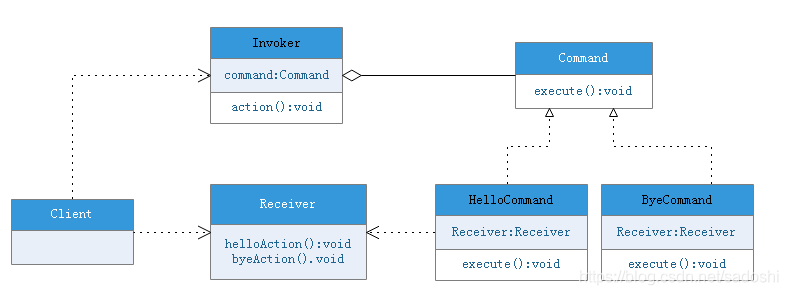activiti中很多api的调用,最终会把这个调用封装成一个命令,使用命令模式去调用。另外还会把命令放在调用链上,当调用该命令时会依次调用职责链上的每一个拦截器(Interceptor),例如日志、事务相关拦截器,然后调用指定的命令。本章先对这两种设计模式进行介绍
命令模式
命令模式其作用是为了对“行为请求者”和“行为实现者”这两者进行解耦。下图是命令模式的UML图。其中HelloCommand和ByeCommand是具体命令,Receiver是命令的实际执行者。Invoker是提供给客户端进行调用的类。

Command.java:
public interface Command {
void execute();
}HelloCommand.java:
public class HelloCommand implements Command {
private Receiver receiver = null;
public HelloCommand(Receiver receiver) {
super();
this.receiver = receiver;
}
public void execute() {
receiver.helloAction();
}
}ByeCommand.java:
public class ByeCommand implements Command {
private Receiver receiver = null;
public ByeCommand(Receiver receiver) {
super();
this.receiver = receiver;
}
public void execute() {
receiver.byeAction();
}
}Receiver.java:
public class Receiver {
public void helloAction() {
System.out.println("hello");
}
public void byeAction() {
System.out.println("good bye");
}
}Invoker.java:
public class Invoker {
private Command command = null;
public Invoker(Command command) {
this.command = command;
}
public void action() {
command.execute();
}
public Command getCommand() {
return command;
}
public void setCommand(Command command) {
this.command = command;
}
}Client.java:
public class Client {
public static void main(String[] args) {
Receiver receiver = new Receiver();
HelloCommand helloCommand = new HelloCommand(receiver);
ByeCommand byeCommand = new ByeCommand(receiver);
Invoker invoker = new Invoker(helloCommand);
invoker.action();
invoker.setCommand(byeCommand);
invoker.action();
}
}有时候命令模式可能省略Receiver,直接在Command实例的execute方法中处理具体逻辑,activiti便是如此。
职责链模式
责任链模式(Chain of Responsibility Pattern)为请求创建了一个接收者对象的链。避免请求发送者与接收者耦合在一起,让多个对象都有可能接收请求,将这些对象连接成一条链,并且沿着这条链传递请求,直到有对象处理它为止。

AbstractHandler.java
public abstract class AbstractHandler {
AbstractHandler next = null;
public void setNext(AbstractHandler next) {
this.next = next;
}
public void handle() {
action();
if(next != null) {
next.handle();
}
}
public abstract void action();
}ConcreteHandlerA.java
public class ConcreteHandlerA extends AbstractHandler{
public void action() {
System.out.println("handle A");
}
}ConcreateHandlerB.java
public class ConcreteHandlerB extends AbstractHandler{
public void action() {
System.out.println("handle B");
}
}Client.java
public class Client {
public static AbstractHandler initChain() {
ConcreteHandlerA concreteHandlerA = new ConcreteHandlerA();
ConcreteHandlerB concreteHandlerB = new ConcreteHandlerB();
concreteHandlerA.setNext(concreteHandlerB);
return concreteHandlerA;
}
public static void main(String[] args) {
AbstractHandler handlerChain = initChain();
handlerChain.handle();
}
}activiti命令相关类
activiti命令相关的类首先在ProcessEngineConfigurationImpl.java中初始化:
protected void initCommandExecutors() {
initDefaultCommandConfig(); //初始化默认命令配置类
initSchemaCommandConfig(); //初始化schema配置类
initCommandInvoker(); //初始化命令调用类
initCommandInterceptors(); //初始化拦截器
initCommandExecutor(); //初始化命令执行器
}初始化命令配置类
ProcessEngineConfigurationImpl.java:
protected void initDefaultCommandConfig() {
if (defaultCommandConfig==null) {
defaultCommandConfig = new CommandConfig();
}
}
private void initSchemaCommandConfig() {
if (schemaCommandConfig==null) {
schemaCommandConfig = new CommandConfig().transactionNotSupported();
}
}配置类的相关代码CommandConfig.java,contextReusePossible表示命令上下文是否可重用,propagation与spring事务传播相关,defaultCommandConfig 使用了默认命令配置类,而schemaCommandConfig则使用transactionNotSupported方法创建的命令配置类:
public class CommandConfig {
private boolean contextReusePossible;
private TransactionPropagation propagation;
public CommandConfig() {
this.contextReusePossible = true;
this.propagation = TransactionPropagation.REQUIRED;
}
//.....省略
public CommandConfig transactionNotSupported() {
CommandConfig config = new CommandConfig();
config.contextReusePossible = false;
config.propagation = TransactionPropagation.NOT_SUPPORTED;
return config;
}
}初始化命令调用类
接下来看看初始化命令调用类,先看ProcessEngineConfigurationImpl.java,如果没有自定义命令调用类,则创建默认的:
protected void initCommandInvoker() {
if (commandInvoker==null) {
commandInvoker = new CommandInvoker();
}
}默认的命令调用类CommandInvoker.java。可以看到execute方法,就是执行我们传入的具体命令类的execute方法,并把上下文作为参数传入:
public class CommandInvoker extends AbstractCommandInterceptor {
@Override
public <T> T execute(CommandConfig config, Command<T> command) {
return command.execute(Context.getCommandContext());
}
@Override
public CommandInterceptor getNext() {
return null;
}
@Override
public void setNext(CommandInterceptor next) {
throw new UnsupportedOperationException("CommandInvoker must be the last interceptor in the chain");
}
}初始化拦截器
拦截器的初始化,也是activiti为职责链而初始化拦截器列表。先看ProcessEngineConfigurationImpl.java:
protected List<CommandInterceptor> commandInterceptors;
protected void initCommandInterceptors() {
if (commandInterceptors==null) {
commandInterceptors = new ArrayList<CommandInterceptor>();
if (customPreCommandInterceptors!=null) {
commandInterceptors.addAll(customPreCommandInterceptors);
}
commandInterceptors.addAll(getDefaultCommandInterceptors());
if (customPostCommandInterceptors!=null) {
commandInterceptors.addAll(customPostCommandInterceptors);
}
commandInterceptors.add(commandInvoker);
}
}
protected Collection< ? extends CommandInterceptor> getDefaultCommandInterceptors() {
List<CommandInterceptor> interceptors = new ArrayList<CommandInterceptor>();
interceptors.add(new LogInterceptor());
CommandInterceptor transactionInterceptor = createTransactionInterceptor();
if (transactionInterceptor != null) {
interceptors.add(transactionInterceptor);
}
interceptors.add(new CommandContextInterceptor(commandContextFactory, this));
return interceptors;
}第5行流程引擎先创建一个list,第7行添加用户自定义前置拦截器,第9行添加默认拦截器,第11行添加后置拦截器,第13行添加命令调用类,命令调用类是职责链的最后一个环节,所以之前初始化CommandInvoker时,看到代码getNext()为null,而setNext()会抛出异常。
第17-28行初始化默认拦截器,19行先添加日志拦截器LogInterceptor,21-24行添加事务拦截器transactionInterceptor,根据不同的流程引擎配置类,createTransactionInterceptor创建的事务拦截器各有不同。StandaloneProcessEngineConfiguration创建的事务拦截器是null,而SpringProcessEngineConfiguration则是SpringTransactionInterceptor。最后26行添加上下文拦截器。
接下来分析日志拦截器LogInterceptor.java。它的代码很简单,就是执行职责链下一个拦截器的execute方法,如果配置了log,就会在调用链的前后输出debug日志:
public class LogInterceptor extends AbstractCommandInterceptor {
private static Logger log = LoggerFactory.getLogger(LogInterceptor.class);
public <T> T execute(CommandConfig config, Command<T> command) {
if (!log.isDebugEnabled()) {
// do nothing here if we cannot log
return next.execute(config, command);
}
log.debug("\n");
log.debug("--- starting {} --------------------------------------------------------", command.getClass().getSimpleName());
try {
return next.execute(config, command);
} finally {
log.debug("--- {} finished --------------------------------------------------------", command.getClass().getSimpleName());
log.debug("\n");
}
}
}接下来看命令上下文拦截器CommandContextInterceptor.java:
public class CommandContextInterceptor extends AbstractCommandInterceptor {
private static final Logger log = LoggerFactory.getLogger(CommandContextInterceptor.class);
protected CommandContextFactory commandContextFactory;
protected ProcessEngineConfigurationImpl processEngineConfiguration;
public CommandContextInterceptor() {
}
//......省略
public <T> T execute(CommandConfig config, Command<T> command) {
CommandContext context = Context.getCommandContext();
boolean contextReused = false;
if (!config.isContextReusePossible() || context == null || context.getException() != null) {
context = commandContextFactory.createCommandContext(command);
}
else {
log.debug("Valid context found. Reusing it for the current command '{}'", command.getClass().getCanonicalName());
contextReused = true;
}
try {
Context.setCommandContext(context);
Context.setProcessEngineConfiguration(processEngineConfiguration);
return next.execute(config, command);
} catch (Exception e) {
context.exception(e);
} finally {
try {
if (!contextReused) {
context.close();
}
} finally {
Context.removeCommandContext();
Context.removeProcessEngineConfiguration();
Context.removeBpmnOverrideContext();
}
}
return null;
}
//......省略
}13-23行先获取或创建一个CommandContext,24-27行把当前的上下文和流程引擎配置压入栈中,再执行职责链的下一个对象的execute方法。执行完之后,36-38行把压入栈中的context和processEngineConfiguration清除:
初始化命令执行器
初始化命令执行器的过程,同时也进行职责链的初始化。先看ProcessEngineConfigurationImpl.java
protected void initCommandExecutor() {
if (commandExecutor==null) {
CommandInterceptor first = initInterceptorChain(commandInterceptors);
commandExecutor = new CommandExecutorImpl(getDefaultCommandConfig(), first);
}
}
protected CommandInterceptor initInterceptorChain(List<CommandInterceptor> chain) {
if (chain==null || chain.isEmpty()) {
throw new ActivitiException("invalid command interceptor chain configuration: "+chain);
}
for (int i = 0; i < chain.size()-1; i++) {
chain.get(i).setNext( chain.get(i+1) );
}
return chain.get(0);
}第3行获取拦截器调用链的头部,这条调用链通过8-16行生成。第4行创建新的任务执行器
CommandExecutorImpl.java:
public class CommandExecutorImpl implements CommandExecutor {
private final CommandConfig defaultConfig;
private final CommandInterceptor first;
public CommandExecutorImpl(CommandConfig defaultConfig, CommandInterceptor first) {
this.defaultConfig = defaultConfig;
this.first = first;
}
public CommandInterceptor getFirst() {
return first;
}
@Override
public CommandConfig getDefaultConfig() {
return defaultConfig;
}
@Override
public <T> T execute(Command<T> command) {
return execute(defaultConfig, command);
}
@Override
public <T> T execute(CommandConfig config, Command<T> command) {
return first.execute(config, command);
}
}当流程引擎开始运行后,程序中调用CommandExecutor的execute方法时,即调用26行,职责链中的拦截器便会一个接一个执行。
至此,我们已经分析了activiti如何调度拦截器和命令的原理,可以结合本文的原理,回头看流程部署的源码,思考一下DeployCmd的调用逻辑。下一章,我们可以自定义命令和拦截器进行测试。
